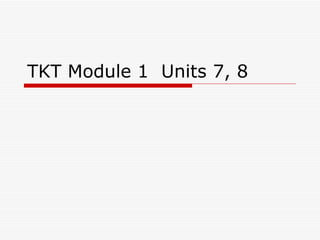
Tkt module 1 units 7,8
- 1. TKT Module 1 Units 7, 8
- 2. Listening Listening is a receptive skill which involves making sense of meaningful sounds of language.
- 3. To listen successfully we need: To understand the context To use our knowledge of language To use our knowledge of the world To understand different text types To understand different speed and accents To use different subskills
- 4. Differences between spoken and written languages: WRITTEN LANGUAGE SPOKEN LANGUAGE Stays on the page Uses punctuation and capital letters to show sentences Consists of letters, words etc. No body language involved Well organized (logical structure) More complex grammar and exact vocabulary
- 5. Differences between spoken and written languages: WRITTEN LANGUAGE SPOKEN LANGUAGE Stays on the page Disappears as soon as it is spoken Uses punctuation and capital letters to show sentences Shows sentences through stress and intonation Consists of letters, words etc. Consists of connected speech, No body language involved sentences, incomplete Well organized (logical sentences or words structure) Body language, facial More complex grammar and expressions, gestures exact vocabulary May have interruptions, repetitions Uses rather general vocabulary and simple grammar
- 6. Spoken texts can be: Coversations Stories Announcements Songs Instructions Lectures Advertisements
- 7. Listening subskills: Listen for gist Specific information Detail Attitude (what attitude a speaker is expressing) Extensive listening
- 8. Separation of subskills training at different age Lower secondary student are trained to: Identify important words Understand and respond to simple instuctions Recognise basic differences in information (commands vs questions) Understand development of a simple story Identify main idea Etc.
- 9. Key concepts: Supply your learners with many sourses of spoken language Listening based on visual support is easier to understand Introduce authentic listening Comprehension activities must be easier than the listening itself Choose interesting stories to listen Vary focus – problem sounds, connected speech, subskills, new language
- 10. Listening activities pattern 1. Intoduction (visualisation) – focus on topic, language 2. Main activities – comprehension, subskills 3. Post activities – personalisation, discussion, dialogues
- 11. Speaking Speaking is a productive skill, like writing, and involves using language to express meanings to other people.
- 12. Pronounce words Respond appropriately Answer questions Persuade Use intonation Tell stories Ask for clarification Start speaking when Correct themselves someone else stops Take part in discussions Use accurate grammar and vocabulary Choose or change register of the language according Use tenses to the situation Take part in conversations Plan what they will say Smile Ask for and give information
- 13. speaking means interaction with one or more people using body language
- 14. Interactive strategies: Making eye contact Using facial expressions Asking check questions Clarifying your mening Confirming understanding
- 15. Speaking subskills: Fluency (speaking at a normal speed, without hesitation, self-correction, repetition with connected speech) Accuracy (using correct forms of grammar, vocabulary and pronunciation)
- 16. Key concepts: Focus learners on particular aspects of speaking Vary controlled practice with freer practice in order not to limit communication Give learners a reason for communicating Give enough support, time and assessment to provide a friendly environment for speaking Think of the way how to control (fluency vs accuracy) Prepare learners for speaking with practiced vocabulary and grammar Don’t forget about TPR and silent period
- 17. Speaking activties pattern Lead-in – intro to the topic Practice activities Post-activities – a task where learners can freely use new language in a situation
